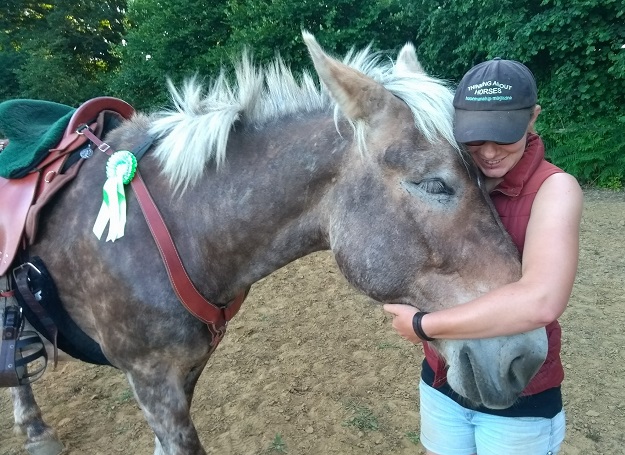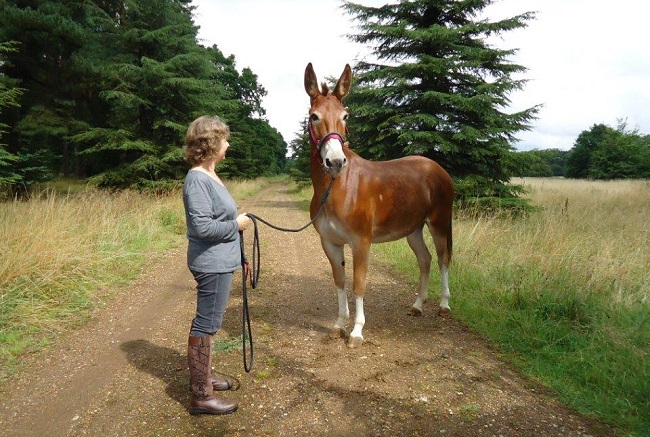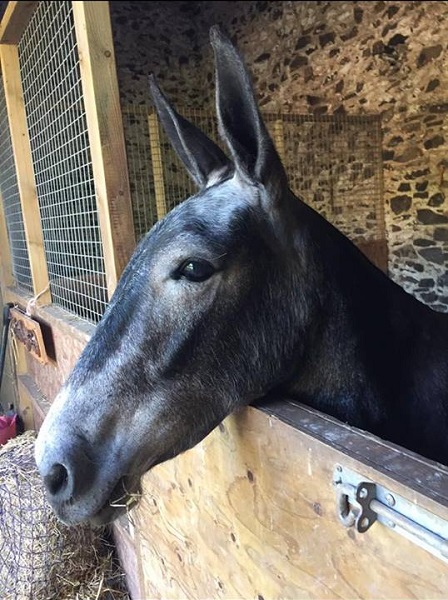With their number approaching one million, we have an equine population crisis in the UK which results in many horses being abandoned and neglected. The main cause of this is overbreeding, as this lowers the value of the individual horses and in turn exposes them to poor standards of welfare and husbandry. A report from World Horse Welfare states: “Horses are also being bred by people who breed small numbers of domestic horses for sale or for their own use. This increases both the supply of horses and the likelihood that other horses will become welfare concerns. In addition, the foals they produce can, in some cases, be from poor stock and therefore have little use or sale value. Over time these can become welfare concerns if their owners try to sell them or find them new homes”. The economy is also a factor and, with Brexit looming, it is worrying to think what will happen to our welfare standards with a weaker pound, falling employment, and without EU regulations.
When it comes to mules, I strongly suspect that there are more mules in sanctuaries than there are in private homes. The Donkey Sanctuary currently have 163 mules in their care on UK farms, and there are mules at various other rescue centres around the country. I haven’t been able to get an exact number of mules in private homes but we think it is around the 140 mark.
Unlike the US and the rest of Europe, many Brits vastly underestimate these marvellous animals and can’t (or won’t) devote the time, patience and training that they need. Mule foals really benefit from early handling but, because most of our mules are the result of an accidental tryst, this initial training is often missed out on. This creates a semi-feral and sometimes unapproachable animal whose behaviour enforces the negative beliefs about mules being stubborn and difficult.

As someone who has imported an equine into this already overflowing situation, I have had to consider the ethics of doing so. I had never actually intended to import, although when it became clear that Marty was a very, very, very long way from ever being rideable, I started looking around and realising that if I wanted a trained mule I would have to look overseas. Xato was offered to me around the time Marty went off for his month of training and I knew I couldn’t turn this literal golden opportunity down.
For me, my conscience is at ease; I have only ever provided forever homes to my equines, and when I got Xato it was with the same understanding. Therefore, I do not feel that his presence adds to the crisis because he will never enter that melee. If my life took such a change that I was no longer able to care for or afford him – and we’re talking about a fairly catastrophic change here – then I would either return him to his “Real Mum” Xanthe, put him to sleep, or send him out on permanent loan with someone trustworthy (this would enable me to step in if the situation ever turned bad, and would not see him passed from pillar to post).
However, there are a couple of controversial elements involved here.
The first is that, even if I am not adding to the crisis, by importing a mule rather than rehoming one I am not detracting from the crisis either. My response to this accusation would be that a) I have technically already rehomed one mule who would almost certainly have found his way to a sanctuary without me and b) I did not want another semi-feral, partially trained mule with questionable behavioural problems, nor did I want to wait for the rare opportunity of a trained mule actually coming up for sale in the UK. Neither of these responses really stand up as a good argument, I know that! However, I am a human being, and we all do selfish things like that sometimes.
The second, more pressing, element is that I have actively encouraged other people to import mules. There are mules in this country because I put people in touch or suggested that what the person was looking for could probably be found on the continent. It is this part that I often wrestle with and what caused me to write this article in the first place.
I feel that, in order to raise the profile of the mule in the UK – and therefore see less of them cast aside, denied the correct training, and ridiculed – we need to be able to show people exactly what a mule can do. This is an easier task with a trained mule who has been purpose bred for the job. Many of us in the UK are pleasure riders and that is precisely what the mule excels at. My husband Ben often says that when people he’s working with describe what they want in a horse, he can’t help but think that what they’re really describing is a mule! It’s just that a mule probably hasn’t occurred to them because they’ve never seen one, they don’t realise they’re rideable or that they even come in big enough sizes to ride, and if presented with a semi-feral or abused mule they may not be capable of sticking it out to see the wonderful creature waiting inside. This isn’t meant as a criticism: I mean, who in their right mind would spend years working with a nervous, difficult animal when there are plenty of easy horses to choose from? Apart from the idiot writing this, of course.
If people know what a mule can be, then they will see mules – all mules – differently. This is very similar to how people might put up with a horse who leans or pulls on the rope constantly because that’s “just how it is”, but once they’ve been exposed to a horse who is light and responsive and weighs nothing in your hand, they will want to seek that out in all the horses they handle because now they know it can be done.
This is not me saying that imported mules are superior to British born mules! Just check out our Mule Tales section to see how many fantastic mules we have. What I mean is that, for a first time mule owner, it is very difficult to find a mule in this country as the choice is limited. You might strike lucky but, generally, we hang onto our mules once we’ve got them because they are just so brilliant.
Whether this is an acceptable reason for bringing more equines into this country is not something I can say. You’ll have to be the judge of that. To give you more food for thought, here are some responses from a few fellow UK mule owners about why they chose to import a mule:

Jenny, who imported Malaga from Spain in 2004.
“Why import instead of rescuing? Has anyone actually seen a ridden mule at a rescue centre? Probably if someone actually started and rode mules, they wouldn’t be in rescue centres; it’s not like the US where there is an overflow. When I was looking for a mule to replace my hinny Sarah-lee, my only choice was importing from Spain … now I know there are riding mules in France but they never seem to get mentioned. I don’t speak foreign languages and can’t travel so my only choice was to find someone to act as an agent – even then my “riding mule suitable for a novice” turned out to be an unbacked two/ three-year-old.
There are only a handful of trainers capable of handling mules in the UK, hence my need of trainer number two. If only people in the UK would think on mules as mules and not donkeys they might get a better chance, as it is they sit in a field (sometimes not even gelded) until the next owner comes along. If you REALLY want a mule, and despite all the problems I’ve had with Malaga, it really is much cheaper to import a trained mule from abroad (and you have more choice).”

Sheril, who imported Diamond from America in 2015.
“I guess my thinking was coloured by the long years of Muffin ownership when I rarely saw mules being ridden in the UK … and most of them I did see were pretty small. So I really didn’t think about rescuing one from a sanctuary – selfishly, I had my heart set on something to take my beloved Muffin’s place. It’s amazing how the mule scene has changed in the intervening years in the UK.”
To hear more, you can read Diamond’s import story.

Reb, who imported Alaska from Mallorca in 2017.
“I first decided to buy a mule after riding them in America on honeymoon. A mule had never appealed to me because I had never come across one (I can’t understand why they aren’t popular in the UK). When I realised that the ranch we were staying on had mules I asked if I could ride one because I never had. They agreed and I was a changed woman! I already had a heavy horse but was also thinking at the time of buying a smaller pony to hack out with my nieces. Something a bit more agile that would fit in the trailer with the others and I could hop on and off to help the kids. So it was decided it had to be a mule.
I have rescued and re-trained horses as a sideline all my adult life so I did feel I should be giving another unwanted pony a chance, but I have saved so many, got them right and found them good homes, just to see them advertised again and again and it is heart-breaking. So I decided to give up on selling and treat myself to one more of my own to keep and it was to be a mule.
At first I went down the obvious root of the Donkey Sanctuary. They came to do a home check and all was good. I waited a long time for them to come across a big enough mule to ride but it was always mini mules. Next plan was perhaps I could breed my own, but that go complicated when the only mares I could find in my price range were ex racers (not what I wanted), and what to do with the mare after and where to find a large enough donkey. I was just about at a dead end when I got in contact with Sari (Mulography) who passed me on to Xanthe. I received lots of pics of many mules (I’d have liked all of them), but with my sensible head on I chose what was right for me and here she is. She will be turning three in a couple of weeks and I have absolutely no regrets on her and very much look forward to our future together.”

Dominic, who imported Frances from Mallorca in 2017.
“Why import a mule when there is an equine over-breeding crisis in the UK?
I’ll have to wind the clock back several years. Around 2008 I was working through my Monty courses which is when I first met a mule called Mrs Moon. She had been imported from the States, and her voice caught my attention. I remember talking to Ian Van Den Burgh at Hartsop farm, and him talking about some of the differences. In 2009 I bought my riding horse, George. He was a green, unbacked five-year-old. Training began. Two years on, I failed to appreciate where he was at developmentally and so we had our incident. I suffered a number of broken bones, punctured lung, and a two week stay in hospital. The end result was a year of ground work. I had always enjoyed the spook busting side of work, but it now became my ‘thing’.
Incremental learning became a real challenge. 2012 I bought a weenling Dartmoor Hill Pony, so I got to work on the increments, and the breaking each thing down to smaller steps, right up to backing. Then came a renewed interest in mules, as the fine tuned learning had really become a way of life. That was really my desire in mule ownership, to work with an equine who gets it first time (whether I do or not, another discussion!). I made enquiries with various pages, and test rode Mrs Moon who by now had come up for sale at Anglesey. While I considered some of the specifics, she sold and moved north of the border to the land of ice and midges.
I made further enquiries with Xanthe and we discussed a mule on Majorca called Delores. Again, I didn’t strike for whatever reason. I had contacted the Donkey Sanctuary, but none of their mules had a great deal of height. At 6’1 I wanted a mule with some height, not necessarily for weight carrying, but for my own comfort of ride. With a renewed interest I got back in touch with Xanthe and Frances arrived here in 2017. She lives with my horse and four ponies. Three Dartmoors from the moor, given a life beyond the inevitable cull, and an older Exmoor I rehomed when a friend became ill. With four fitting the broad term of rehomed (the term rescue is another debate, they weren’t neglected so rehomed is more appropriate), I have no issue with affording myself the luxury of importing an equine I had gone searching for, who fits a specific search.”


So pretty! Their coats are stunning, really.